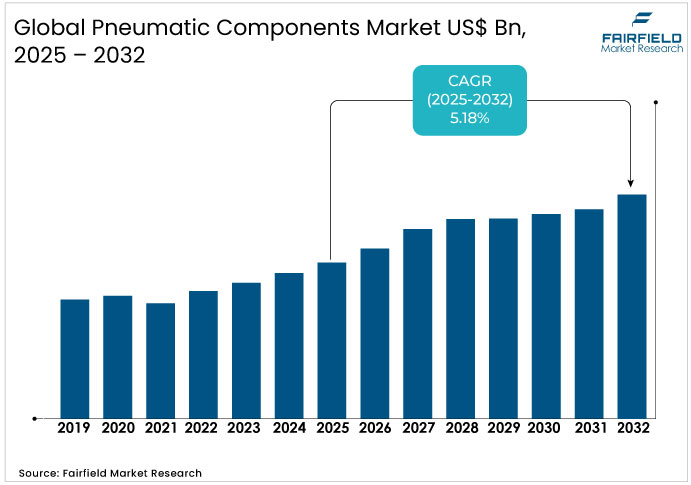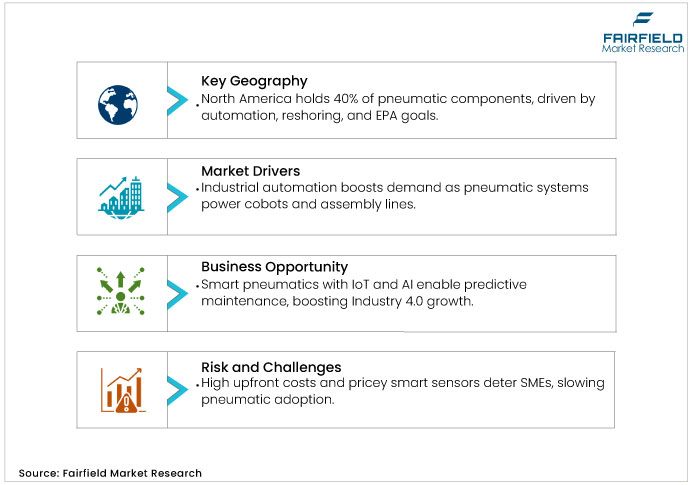Pneumatic Components Market Growth and Industry Forecast
The pneumatic components market is valued at USD 20.74 Billion in 2025 and is projected to reach USD 29.53 Billion by 2032, growing at a CAGR of 5.18%.

Pneumatic Components Market Summary: Key Insights & Trends
- Valves lead the product type segment with over 40% share in 2025, maintaining dominance in flow control applications.
- Actuators, holding 22% share, emerge as the fastest-growing product type driven by robotics and automation trends.
- Industrial manufacturing dominates end-use with 35% share, reflecting strong reliance on pneumatics in assembly lines.
- Electronics & semiconductors capture 18% share, fueled by demand for cleanroom-compatible components in chip production.
- Industrial automation remains the primary growth driver, integrating pneumatics into collaborative robots and smart assembly lines.
- Smart pneumatics with IoT integration presents a key opportunity, enabling predictive maintenance and efficiency gains.
- North America leads regionally with over 40% share, supported by reshoring initiatives and policy incentives.
- Asia Pacific holds 30% share of pneumatic components market, emerging as the fastest-growing region through industrialization and semiconductor expansion.
Key Growth Drivers
- Industrial Automation Growth Boosts Pneumatic Component Adoption in Modern Manufacturing
The surge in industrial automation represents a core driver for the pneumatic components market, as pneumatic systems provide reliable, cost-effective actuation in robotic and assembly applications. According to the U.S. Department of Commerce, industrial automation equipment exports recovered 15% in 2024, signaling robust sector investment. This trend ties to broader technological advancements, such as the adoption of collaborative robots (cobots), which rely on pneumatic valves for precise motion control.
Regulatory changes, including OSHA's updated guidelines on workplace automation safety, encourage firms to upgrade legacy systems, boosting component demand. Demographically, an aging workforce in developed economies heightens reliance on automation, with the International Labour Organization noting a 20% productivity gain from such shifts. Overall, this driver enhances market efficiency, enabling manufacturers to scale operations while minimizing downtime, projecting a 25% increase in pneumatic integration across factories by 2027.
- Energy Efficiency Regulations Drive Demand for Advanced Pneumatic Component Designs
Stringent energy efficiency regulations propel pneumatic component adoption, favoring low-leakage designs that cut compressed air losses. The EU's Ecodesign Directive, effective 2024, mandates 15% energy reductions in industrial compressors, per European Commission reports, directly impacting component specifications. Technological developments such as variable speed drives in air treatment units align with these rules, offering up to 35% savings in operational costs.
Macroeconomic pressures from rising energy prices-up 12% globally in 2024 according to the International Energy Agency-amplify this, pushing industries toward compliant upgrades. Demographic shifts toward sustainable practices, evidenced by 68% of executives prioritizing green tech in Deloitte surveys, further embed these components. The impact manifests in sustained market penetration, as firms leverage pneumatics for compliant, high-margin production lines, fostering long-term resilience against volatility.

Key Restraints
- High Initial Investment Costs Restrict Pneumatic System Adoption Among SMEs
Elevated upfront costs for advanced pneumatic systems pose a significant barrier, particularly for small and medium enterprises comprising 90% of global manufacturers per World Bank data. Integration of smart sensors and energy-efficient actuators can add 20-30% to capital expenditures, deterring adoption amid tight budgets. Supply chain bottlenecks, exacerbated by raw material price hikes of 15% in 2024 due to geopolitical tensions, compound this issue. Competitive threats from hydraulic alternatives, which offer higher force in niche applications, further pressure margins. These factors slow market entry, potentially capping growth in cost-sensitive segments and underscoring the need for financing models to bridge adoption gaps.
- Global Supply Chain Vulnerabilities Challenge Pneumatic Component Availability and Growth
Persistent supply chain disruptions hinder reliable component availability, with semiconductor shortages delaying pneumatic control unit production by up to 25% as noted in U.S. International Trade Commission filings. Regulatory hurdles, including export controls on critical materials, amplify delays in global sourcing. Competitor dynamics intensify as leading suppliers prioritize large clients, leaving smaller orders underserved. Bottlenecks in rare earth elements for actuators threaten scalability, risking 10-15% output losses in affected industries. This restraint erodes confidence, prompting diversification strategies to stabilize inflows and protect against future shocks.
Pneumatic Components Market Trends and Opportunities
- Smart Pneumatics and IoT Integration Unlock Growth in Industry 4.0 Era
The rise of smart pneumatics, incorporating IoT and AI for predictive maintenance, unlocks substantial opportunities amid Industry 4.0 transitions. This segment could capture 15-20% of the market by 2030, valued at over US$4 billion, driven by real-time monitoring that slashes downtime by 50% per McKinsey analyses on digital twins. Emerging technologies such as edge computing enable self-optimizing valves, addressing unmet demand for adaptive systems in volatile environments. Supportive policies, including U.S. CHIPS Act subsidies totaling US$52 billion for semiconductor integration, lower barriers for innovators. In developing economies, where 70% of factories lack digital tools per World Economic Forum surveys, this presents a greenfield for scalable deployments. Firms targeting this could achieve 25% margin uplifts through premium pricing, while fostering ecosystems for data-driven efficiency gains.
- Sustainable Manufacturing Practices Create Opportunities for Eco-Friendly Pneumatic Components
Sustainable manufacturing trends offer a pivotal opportunity, as pneumatic components evolve to support circular economy models with recyclable materials and low-emission designs. This niche may grow to US$6-8 billion by 2032, propelled by global ESG mandates requiring 40% emission cuts by 2030 under Paris Agreement frameworks. Unmet customer needs for eco-friendly actuators in food processing-where waste reduction targets 30% per FAO guidelines-create entry points. Policy changes such as EU Green Deal subsidies exceeding €1 trillion bolster R&D, enabling cost-effective innovations. In emerging markets such as India, where renewable energy capacity doubled to 200 GW in 2024 per Ministry of New and Renewable Energy, demand surges for green pneumatics. Strategic players can leverage this for 20% revenue diversification, mitigating regulatory risks and capitalizing on premium sustainable branding.

Segment-wise Trends & Analysis
Valves Lead Pneumatic Components Market as Actuators Emerge as Fastest-Growing Segment
The valves segment leads the pneumatic components market with over 40% share in 2025, valued at approximately USD 8.3 billion, due to their essential role in flow control across applications. Air treatment components follow at 25%, but actuators emerge as the fast-growing segment at 22% share, projected to expand with sustainable CAGR through 2032 on automation demands.
Actuators' growth trajectory is anchored in precision needs for robotics, where linear and rotary variants enable 30% faster cycle times. Drivers include miniaturization trends reducing size by 20% for electronics integration. Competitive positioning favors innovators such as Festo, holding 15% in actuators via modular designs.
Industrial Manufacturing Dominates Pneumatics Market as Electronics and Semiconductors Gain Momentum
Industrial manufacturing dominates with over 35% of pneumatic components market share in 2025, equating to USD 7.26 billion, fueled by assembly line reliance on pneumatics for durability. Electronics & Semiconductors represent the emerging segment at 18% share, growing with robust CAGR amid chip fabrication booms.
Electronics growth stems from cleanroom-compatible components, supporting 25% output hikes in wafer handling. Drivers encompass semiconductor investments hitting US$500 billion globally per SEMI.org. Competitive landscape sees SMC leading at 20% in electronics through contamination-free valves.
Regional Trends & Analysis
North America Leads Pneumatic Components Industry with Strong Reshoring and Policy Support
North America commands over 40% of the global pneumatic components market in 2025, valued at USD 8.3 billion, propelled by advanced manufacturing hubs and automation incentives. Key trends include reshoring initiatives, with 78% of executives planning domestic expansions per Reshoring Institute surveys, alongside a focus on sustainable tech amid EPA efficiency mandates.

U.S. Pneumatic Components Market - 2025 Snapshot & Outlook
Automation reshoring drives U.S. demand, with pneumatic valves integral to 60% of new robotic installs per Association for Advancing Automation data. Government policies such as the Inflation Reduction Act provide US$369 billion in clean manufacturing credits, enhancing margins by 15% for compliant suppliers. A key trend is the shift to energy-efficient systems, where DOE reports indicate 22% air loss reductions via smart regulators. Consumer surveys from the National Association of Manufacturers reveal 65% prioritize sustainable components, citing cost savings. Policy support via tax incentives under Section 45X boosts domestic production, yielding 12% cost advantages over imports. Trends favor IoT-integrated actuators for predictive maintenance in automotive plants. SEMI data shows semiconductor fabs demanding 30% more precision pneumatics.
Europe Holds Significant Pneumatic Components Share with Sustainability and Precision Focus
Europe holds 25% of pneumatic components market share in 2025, at USD 5.19 billion, characterized by stringent sustainability regulations and precision engineering legacies. Local trends emphasize circular economy integration, with the Ellen MacArthur Foundation noting 50% recyclable material use in components by 2025, alongside digital twin adoption in 40% of factories.
Germany Pneumatic Components Market - 2025 Snapshot & Outlook
Germany's engineering prowess fuels pneumatic demand, with industrial manufacturing absorbing 45% of components amid Mittelstand upgrades. The Energiewende policy offers €40 billion in efficiency grants, improving supplier margins by 18% through low-emission tech. A prominent trend is AI-enhanced valves, reducing failures by 35% per VDMA association surveys. Eurostat data highlights 55% of manufacturers favoring pneumatics for reliability in export-oriented sectors. Automotive transitions to EVs drive actuator innovations, with KfW banking subsidies easing 20% capex hikes. Trends include cobot proliferation, boosting 25% in small-batch production. Regulatory alignment with REACH standards ensures contamination-free air treatment. This fortifies Germany's leadership, navigating energy transitions adeptly.
U.K. Pneumatic Components Market - 2025 Snapshot & Outlook
The U.K.'s post-Brexit manufacturing revival spurs pneumatic adoption, with food & beverage sectors leading at 28% usage for hygienic processing. The Advanced Manufacturing Plan allocates £4.5 billion in R&D grants, yielding 14% margin gains for innovative suppliers. Trends center on resilient supply chains, where Make UK surveys show 58% prioritizing local sourcing post-disruptions. ONS statistics indicate 20% productivity lifts from pneumatic retrofits in legacy plants. Fiscal policies such as R&D tax credits under the Spring Statement reduce effective costs by 25%. Electronics growth demands precision filters, aligning with 15% fab expansions. Consumer shift to sustainable packaging drives 30% actuator upgrades. These dynamics position the U.K. for balanced growth, balancing innovation with trade frictions.
Asia Pacific Emerges as Fastest-Growing Pneumatic Components Region with Industrialization
Asia Pacific emerges as the fastest-growing region at 30% share in 2025, valued at USD 6.22 billion, driven by rapid industrialization and electronics booms. Trends feature supply chain localization, with ASEAN Economic Community reports showing 35% intra-regional trade in automation gear, coupled with green tech subsidies accelerating adoption.
Japan Pneumatic Components Market - 2025 Snapshot & Outlook
Japan's precision focus propels pneumatics in semiconductors, where components support 70% of cleanroom operations. The Green Growth Strategy invests ¥2 trillion in efficient manufacturing, enhancing margins 16% via subsidy-backed upgrades. Trends include aging workforce automation, with 45% robot density stats favoring reliable actuators. A survey by the Japan Robot Association reveals 67% preference for energy-saving valves. Policy-driven semiconductor incentives under the Economic Security Act cut import reliance by 22%. Automotive electrification trends demand lightweight designs, boosting 28% in EV lines. Regulatory pushes for carbon neutrality enforce 25% leak reductions. This sustains Japan's edge, amid demographic pressures.
India Pneumatic Components Market - 2025 Snapshot & Outlook
India's manufacturing push, via Make in India, elevates pneumatics in textiles and pharma, comprising 32% end-use. PLI schemes disburse US$25 billion, improving supplier margins 19% through localized production. Trends encompass digital adoption, where CII surveys indicate 52% factories piloting IoT pneumatics for 18% yield gains. DPIIT data shows 40% import substitution in components. Growth at 7.5% CAGR reflects demographic dividends. Tax holidays under GST reforms lower costs 12% for exporters. Electronics trends, with US$10 billion incentives, spike actuator needs by 35%. A NITI Aayog report cites 60% SMEs shifting to sustainable models. These factors accelerate India's ascent, addressing infrastructure gaps.
Competitive Landscape Analysis
The players in the pneumatic components market are focusing on technological innovation to capture the growing demand for smart, energy-efficient systems. In 2024, R&D investments by key players such as SMC Corporation and Festo SE increased by 12%, targeting IoT-enabled components. M&A activity, such as IMI’s acquisition of Norgren, enhances global footprints, while regulatory changes such as U.S. DOE standards drive cost-competitive upgrades. Early movers will benefit from premium pricing for smart systems, while latecomers may face margin pressures due to commoditization.
Key Companies
- SMC Corporation.
- Festo SE & Co. KG
- Parker Hannifin Corporation.
- Emerson Electric Co.
- Norgren, Inc. (IMI, PIC)
- Bosch Rexroth AG
- Airtac International Group.
- JELPC (Ningbo Jiaerling Pneumatic Machinery Co., Ltd.)
- Zhaoqing Fangda pneumatic Co. Ltd
- Camozzi Group
Recent Developments:
- March 2025, Festo has introduced a new piezo-based flow-control system for FOUP purge applications in semiconductor fabs, cutting nitrogen gas use by up to 75% while lowering energy consumption and CO₂ emissions. The technology not only saves millions in electricity costs but also improves particle control, system accuracy, and service life with minimal maintenance.
- September 2025, Pneumatic technology is evolving with Industry 4.0, as manufacturers adopt industrial ethernet, IO-Link, and advanced sensors to enable real-time monitoring, predictive maintenance, and smarter decision-making. In future smart factories, pneumatics will play a key role in automation and sustainability-boosting flexibility, efficiency, and energy savings while supporting manufacturers’ productivity and carbon reduction goals.
- July 2024, Emerson has unveiled its AVENTICS™ Series XV pneumatic valves, a globally adaptable platform designed for flexible, high-performance automation across industries such as automotive, packaging, and factory systems. Offering compact design, high flow rates, and broad connectivity with leading fieldbus protocols, the Series XV enables easier integration, productivity gains, and customization for diverse market needs.
Global Pneumatic Components Market Segmentation-
By Product Type
- Valves
- Air Treatment Components
- Actuators
- Others
By End Use
- Automotive
- Food & Beverage
- Industrial Manufacturing
- Electronics & Semiconductors
- Others
By Region
- North America
- Europe
- Asia Pacific
- Latin America
- Middle East & Africa
1. Executive Summary
1.1. Global Pneumatic Components Market Snapshot
1.2. Future Projections
1.3. Key Market Trends
1.4. Regional Snapshot, by Value, 2025
1.5. Analyst Recommendations
2. Market Overview
2.1. Market Definitions and Segmentations
2.2. Market Dynamics
2.2.1. Drivers
2.2.2. Restraints
2.2.3. Market Opportunities
2.3. Value Chain Analysis
2.4. COVID-19 Impact Analysis
2.5. Porter's Fiver Forces Analysis
2.6. Impact of Russia-Ukraine Conflict
2.7. PESTLE Analysis
2.8. Regulatory Analysis
2.9. Price Trend Analysis
2.9.1. Current Prices and Future Projections, 2024-2032
2.9.2. Price Impact Factors
3. Global Pneumatic Components Market Outlook, 2019 - 2032
3.1. Global Pneumatic Components Market Outlook, by Product Type, Value (US$ Bn), 2019 - 2032
3.1.1. Valves
3.1.2. Air Treatment Components
3.1.3. Actuators
3.1.4. Others
3.2. Global Pneumatic Components Market Outlook, by End Use, Value (US$ Bn), 2019 - 2032
3.2.1. Automotive
3.2.2. Food & Beverage
3.2.3. Industrial Manufacturing
3.2.4. Electronics & Semiconductors
3.2.5. Others
3.3. Global Pneumatic Components Market Outlook, by Region, Value (US$ Bn), 2019 - 2032
3.3.1. North America
3.3.2. Europe
3.3.3. Asia Pacific
3.3.4. Latin America
3.3.5. Middle East & Africa
4. North America Pneumatic Components Market Outlook, 2019 - 2032
4.1. North America Pneumatic Components Market Outlook, by Product Type, Value (US$ Bn), 2019 - 2032
4.1.1. Valves
4.1.2. Air Treatment Components
4.1.3. Actuators
4.1.4. Others
4.2. North America Pneumatic Components Market Outlook, by End Use, Value (US$ Bn), 2019 - 2032
4.2.1. Automotive
4.2.2. Food & Beverage
4.2.3. Industrial Manufacturing
4.2.4. Electronics & Semiconductors
4.2.5. Others
4.3. North America Pneumatic Components Market Outlook, by Country, Value (US$ Bn), 2019 - 2032
4.3.1. U.S. Pneumatic Components Market Outlook, by Product Type, 2019 - 2032
4.3.2. U.S. Pneumatic Components Market Outlook, by End Use, 2019 - 2032
4.3.3. Canada Pneumatic Components Market Outlook, by Product Type, 2019 - 2032
4.3.4. Canada Pneumatic Components Market Outlook, by End Use, 2019 - 2032
4.4. BPS Analysis/Market Attractiveness Analysis
5. Europe Pneumatic Components Market Outlook, 2019 - 2032
5.1. Europe Pneumatic Components Market Outlook, by Product Type, Value (US$ Bn), 2019 - 2032
5.1.1. Valves
5.1.2. Air Treatment Components
5.1.3. Actuators
5.1.4. Others
5.2. Europe Pneumatic Components Market Outlook, by End Use, Value (US$ Bn), 2019 - 2032
5.2.1. Automotive
5.2.2. Food & Beverage
5.2.3. Industrial Manufacturing
5.2.4. Electronics & Semiconductors
5.2.5. Others
5.3. Europe Pneumatic Components Market Outlook, by Country, Value (US$ Bn), 2019 - 2032
5.3.1. Germany Pneumatic Components Market Outlook, by Product Type, 2019 - 2032
5.3.2. Germany Pneumatic Components Market Outlook, by End Use, 2019 - 2032
5.3.3. Italy Pneumatic Components Market Outlook, by Product Type, 2019 - 2032
5.3.4. Italy Pneumatic Components Market Outlook, by End Use, 2019 - 2032
5.3.5. France Pneumatic Components Market Outlook, by Product Type, 2019 - 2032
5.3.6. France Pneumatic Components Market Outlook, by End Use, 2019 - 2032
5.3.7. U.K. Pneumatic Components Market Outlook, by Product Type, 2019 - 2032
5.3.8. U.K. Pneumatic Components Market Outlook, by End Use, 2019 - 2032
5.3.9. Spain Pneumatic Components Market Outlook, by Product Type, 2019 - 2032
5.3.10. Spain Pneumatic Components Market Outlook, by End Use, 2019 - 2032
5.3.11. Russia Pneumatic Components Market Outlook, by Product Type, 2019 - 2032
5.3.12. Russia Pneumatic Components Market Outlook, by End Use, 2019 - 2032
5.3.13. Rest of Europe Pneumatic Components Market Outlook, by Product Type, 2019 - 2032
5.3.14. Rest of Europe Pneumatic Components Market Outlook, by End Use, 2019 - 2032
5.4. BPS Analysis/Market Attractiveness Analysis
6. Asia Pacific Pneumatic Components Market Outlook, 2019 - 2032
6.1. Asia Pacific Pneumatic Components Market Outlook, by Product Type, Value (US$ Bn), 2019 - 2032
6.1.1. Valves
6.1.2. Air Treatment Components
6.1.3. Actuators
6.1.4. Others
6.2. Asia Pacific Pneumatic Components Market Outlook, by End Use, Value (US$ Bn), 2019 - 2032
6.2.1. Automotive
6.2.2. Food & Beverage
6.2.3. Industrial Manufacturing
6.2.4. Electronics & Semiconductors
6.2.5. Others
6.3. Asia Pacific Pneumatic Components Market Outlook, by Country, Value (US$ Bn), 2019 - 2032
6.3.1. China Pneumatic Components Market Outlook, by Product Type, 2019 - 2032
6.3.2. China Pneumatic Components Market Outlook, by End Use, 2019 - 2032
6.3.3. Japan Pneumatic Components Market Outlook, by Product Type, 2019 - 2032
6.3.4. Japan Pneumatic Components Market Outlook, by End Use, 2019 - 2032
6.3.5. South Korea Pneumatic Components Market Outlook, by Product Type, 2019 - 2032
6.3.6. South Korea Pneumatic Components Market Outlook, by End Use, 2019 - 2032
6.3.7. India Pneumatic Components Market Outlook, by Product Type, 2019 - 2032
6.3.8. India Pneumatic Components Market Outlook, by End Use, 2019 - 2032
6.3.9. Southeast Asia Pneumatic Components Market Outlook, by Product Type, 2019 - 2032
6.3.10. Southeast Asia Pneumatic Components Market Outlook, by End Use, 2019 - 2032
6.3.11. Rest of SAO Pneumatic Components Market Outlook, by Product Type, 2019 - 2032
6.3.12. Rest of SAO Pneumatic Components Market Outlook, by End Use, 2019 - 2032
6.4. BPS Analysis/Market Attractiveness Analysis
7. Latin America Pneumatic Components Market Outlook, 2019 - 2032
7.1. Latin America Pneumatic Components Market Outlook, by Product Type, Value (US$ Bn), 2019 - 2032
7.1.1. Valves
7.1.2. Air Treatment Components
7.1.3. Actuators
7.1.4. Others
7.2. Latin America Pneumatic Components Market Outlook, by End Use, Value (US$ Bn), 2019 - 2032
7.2.1. Automotive
7.2.2. Food & Beverage
7.2.3. Industrial Manufacturing
7.2.4. Electronics & Semiconductors
7.2.5. Others
7.3. Latin America Pneumatic Components Market Outlook, by Country, Value (US$ Bn), 2019 - 2032
7.3.1. Brazil Pneumatic Components Market Outlook, by Product Type, 2019 - 2032
7.3.2. Brazil Pneumatic Components Market Outlook, by End Use, 2019 - 2032
7.3.3. Mexico Pneumatic Components Market Outlook, by Product Type, 2019 - 2032
7.3.4. Mexico Pneumatic Components Market Outlook, by End Use, 2019 - 2032
7.3.5. Argentina Pneumatic Components Market Outlook, by Product Type, 2019 - 2032
7.3.6. Argentina Pneumatic Components Market Outlook, by End Use, 2019 - 2032
7.3.7. Rest of LATAM Pneumatic Components Market Outlook, by Product Type, 2019 - 2032
7.3.8. Rest of LATAM Pneumatic Components Market Outlook, by End Use, 2019 - 2032
7.4. BPS Analysis/Market Attractiveness Analysis
8. Middle East & Africa Pneumatic Components Market Outlook, 2019 - 2032
8.1. Middle East & Africa Pneumatic Components Market Outlook, by Product Type, Value (US$ Bn), 2019 - 2032
8.1.1. Valves
8.1.2. Air Treatment Components
8.1.3. Actuators
8.1.4. Others
8.2. Middle East & Africa Pneumatic Components Market Outlook, by End Use, Value (US$ Bn), 2019 - 2032
8.2.1. Automotive
8.2.2. Food & Beverage
8.2.3. Industrial Manufacturing
8.2.4. Electronics & Semiconductors
8.2.5. Others
8.3. Middle East & Africa Pneumatic Components Market Outlook, by Country, Value (US$ Bn), 2019 - 2032
8.3.1. GCC Pneumatic Components Market Outlook, by Product Type, 2019 - 2032
8.3.2. GCC Pneumatic Components Market Outlook, by End Use, 2019 - 2032
8.3.3. South Africa Pneumatic Components Market Outlook, by Product Type, 2019 - 2032
8.3.4. South Africa Pneumatic Components Market Outlook, by End Use, 2019 - 2032
8.3.5. Egypt Pneumatic Components Market Outlook, by Product Type, 2019 - 2032
8.3.6. Egypt Pneumatic Components Market Outlook, by End Use, 2019 - 2032
8.3.7. Nigeria Pneumatic Components Market Outlook, by Product Type, 2019 - 2032
8.3.8. Nigeria Pneumatic Components Market Outlook, by End Use, 2019 - 2032
8.3.9. Rest of Middle East Pneumatic Components Market Outlook, by Product Type, 2019 - 2032
8.3.10. Rest of Middle East Pneumatic Components Market Outlook, by End Use, 2019 - 2032
8.4. BPS Analysis/Market Attractiveness Analysis
9. Competitive Landscape
9.1. Company Vs Segment Heatmap
9.2. Company Market Share Analysis, 2024
9.3. Competitive Dashboard
9.4. Company Profiles
9.4.1. SMC Corporation.
9.4.1.1. Company Overview
9.4.1.2. Product Portfolio
9.4.1.3. Financial Overview
9.4.1.4. Business Strategies and Developments
9.4.2. Festo SE & Co. KG
9.4.2.1. Company Overview
9.4.2.2. Product Portfolio
9.4.2.3. Financial Overview
9.4.2.4. Business Strategies and Developments
9.4.3. Parker Hannifin Corporation.
9.4.3.1. Company Overview
9.4.3.2. Product Portfolio
9.4.3.3. Financial Overview
9.4.3.4. Business Strategies and Developments
9.4.4. Emerson Electric Co.
9.4.4.1. Company Overview
9.4.4.2. Product Portfolio
9.4.4.3. Financial Overview
9.4.4.4. Business Strategies and Developments
9.4.5. Norgren, Inc. (IMI, PIC)
9.4.5.1. Company Overview
9.4.5.2. Product Portfolio
9.4.5.3. Financial Overview
9.4.5.4. Business Strategies and Developments
9.4.6. Bosch Rexroth AG
9.4.6.1. Company Overview
9.4.6.2. Product Portfolio
9.4.6.3. Financial Overview
9.4.6.4. Business Strategies and Developments
9.4.7. Airtac International Group.
9.4.7.1. Company Overview
9.4.7.2. Product Portfolio
9.4.7.3. Financial Overview
9.4.7.4. Business Strategies and Developments
9.4.8. JELPC (Ningbo Jiaerling Pneumatic Machinery Co., Ltd.)
9.4.8.1. Company Overview
9.4.8.2. Product Portfolio
9.4.8.3. Financial Overview
9.4.8.4. Business Strategies and Developments
9.4.9. Zhaoqing Fangda pneumatic Co. Ltd
9.4.9.1. Company Overview
9.4.9.2. Product Portfolio
9.4.9.3. Financial Overview
9.4.9.4. Business Strategies and Developments
9.4.10. Camozzi Group
9.4.10.1. Company Overview
9.4.10.2. Product Portfolio
9.4.10.3. Financial Overview
9.4.10.4. Business Strategies and Developments
10. Appendix
10.1. Research Methodology
10.2. Report Assumptions
10.3. Acronyms and Abbreviations
|
BASE YEAR |
HISTORICAL DATA |
FORECAST PERIOD |
UNITS |
|||
|
2024 |
|
2019 - 2024 |
2025 - 2032 |
Value: US$ Billion |
||
|
REPORT FEATURES |
DETAILS |
|
Product Type Coverage |
|
|
End Use Coverage |
|
|
Geographical Coverage |
|
|
Leading Companies |
|
|
Report Highlights |
Key Market Indicators, Macro-micro economic impact analysis, Technological Roadmap, Key Trends, Driver, Restraints, and Future Opportunities & Revenue Pockets, Porter’s 5 Forces Analysis, Historical Trend (2019-2024), Market Estimates and Forecast, Market Dynamics, Industry Trends, Competition Landscape, Category, Region, Country-wise Trends & Analysis, COVID-19 Impact Analysis (Demand and Supply Chain) |
